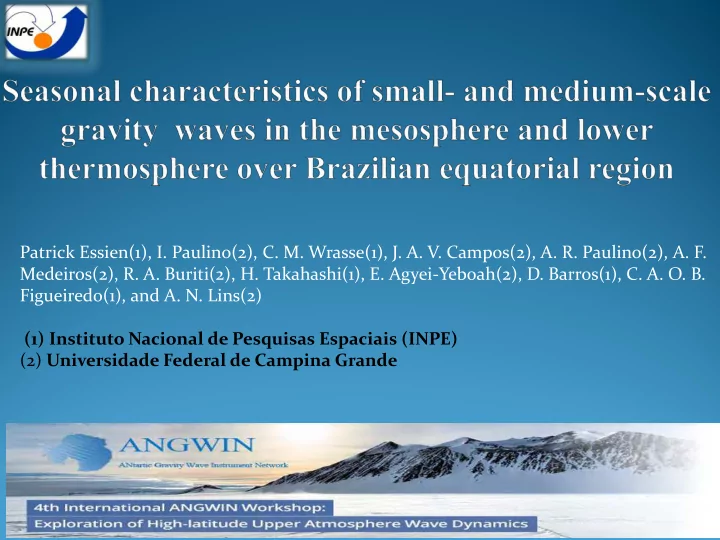

Patrick Essien(1), I. Paulino(2), C. M. Wrasse(1), J. A. V. Campos(2), A. R. Paulino(2), A. F. Medeiros(2), R. A. Buriti(2), H. Takahashi(1), E. Agyei-Yeboah(2), D. Barros(1), C. A. O. B. Figueiredo(1), and A. N. Lins(2) (1) Instituto Nacional de Pesquisas Espaciais (INPE) (2) Universidade Federal de Campina Grande
OUTLINE Introduction - Objectives Image Analysis Results & Discussion Summary
Objectives • Seasonal characteristics of SSGWs and MSGWs in the MLT region over Brazilian equatorial region for the first time. • Apply the critical level theory to study the effects of wind filtering on SSGWs and MSGWs propagation directions in the middle atmosphere. • The possible wave source region in the troposphere
Image Analysis (a) (b (c). Raw Image The linearized and rotated The image after the image ready for the stars have been FFT analysis removed
Estimation of parameters of SSGWs using 2D spectrum OH Cariri Feb. 25-26, 2001 OH, Cariri, Feb. 25-26, 2001
Keogram
Results The yearly distribution of the SSGWs, MSGWs events, clear sky, cloudy and observed nights
The average monthly distribution of the SSGWs, MSGWs events, clear sky nights, cloudy nights and observed nights
MSGWs SSGWs
There are two main factors which could create the observed anisotropy of AGWs propagation (Fritts et al., 2008). OH • Filtering process by the background wind • Location of the wave source region
• The Outgoing Longwave Radiation (OLR) data was obtained from the • Using HWM- 07 as the parameter for National Oceanic and Atmospheric Administration (NOAA) to localize the the background wind deep convective regions
Critical Layer • This situation may occur at any height level when the local horizontal wind speed along the direction of propagation equals the observed horizontal phase speed of the gravity wave (Taylor et al. 1993) • Following the analysis by Booker and Bretherton (1967), and ignoring the terms involving isothermal scale height, etc in Taylor-Goldstein equation • The Doppler- shifted frequency, Ω, due to the horizontal wind V o is given by Source Frequency horizontal wave vector • Component of horizontal wind along v x • where v x is the observed horizontal phase speed of the wave • the critical layer when V ox = v x Doppler shifted • where Vz and Vm are the zonal and the meridionawl wind components
2000 2001
2004 2007
2006 2009
Oct-12-2009 Oct-13-2009 Oct-14-2009 Oct-17-2009 Oct-15-2009 Oct-16-2009
Nov-09-2009 Nov-12-2009 Nov-19-2009
Summary • Eleven years of AGWs observations were made from NIR-OH emissions using an all- sky airglow imager at Cariri . • The measurements were made from September 2000 to December 2010, with a total of 1252 nights of clear sky. • In summer, fall and winter both SSGWs and MSGWs propagated preferentially northeastward and southeastward, while in spring the waves propagated in all directions. • The horizontal propagation directions of SSGWs and MSGWs show clear seasonal variations based on the influence of the wind filtering process and wave source location
THANK YOU
Recommend
More recommend